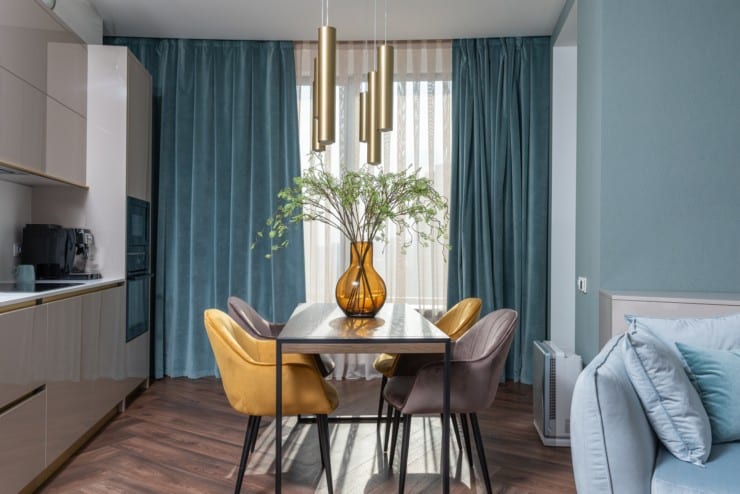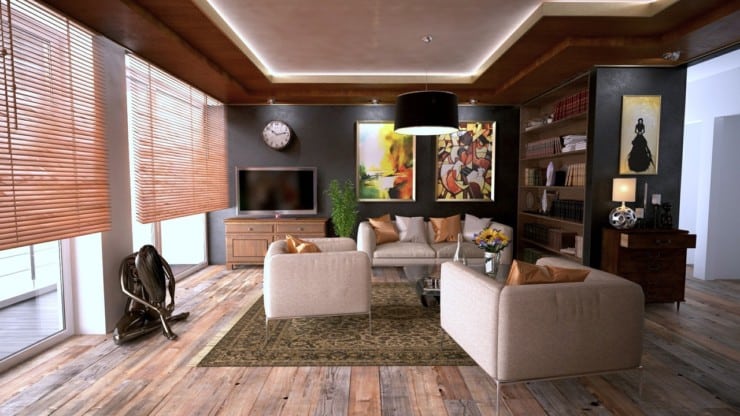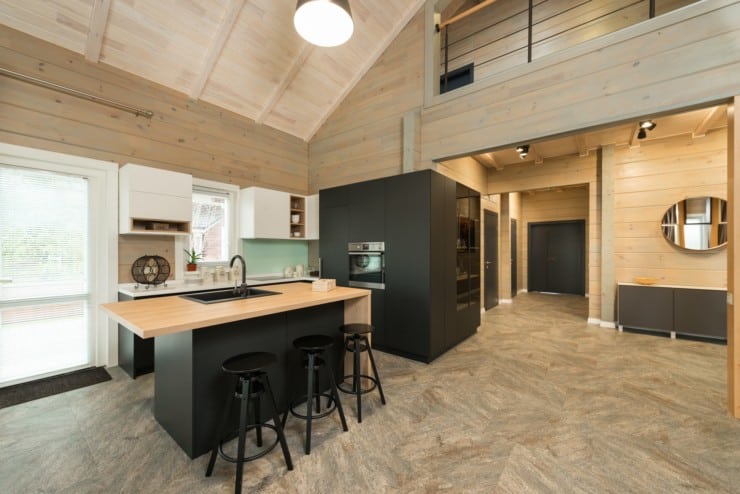10 Methods to Reducing Echo in a Room Cheaply
If you have found yourself in a spacious loft or a vast public space with tall ceilings, you may have observed a particular ringing noise known as flutter echo.
It happens when sound waves bounce back and forth between the walls.
The echo problem also happens in homes and workplaces. High ceilings, empty spaces, and wooden flooring are some reasons behind the echo problem.
Excessive echo can make a room less pleasant and irritable. It multiplies the sounds and makes it tough to conduct conversations in that room.
10 Inexpensive Ways to Reduce Room Echo

Too much echo in a room can be distracting.
This article compiles 10 effective and cheap methods to help you develop a plan of attack against the rouge sound waves.
You can follow these techniques without breaking the bank. If you implement multiple methods at once, you will find a drastic reduction in the echoes.
Let’s get started without further ado.
1. Cover the Floor
As mentioned earlier, hardwood floors can be one of the main drivers of echo in a room.
On the other hand, a carpeted room experiences far less echo than the rooms with hardwood flooring.
Carpets and sound-absorbing rugs can deaden the sound reflection in a room by absorbing the echoes and muffling noises. A fluffy rug serves a great aesthetic purpose and works wonders on the echoes.
In rooms with hardwood flooring, place area rugs to complement your décor. Or you can go for wall-to-wall carpeting.
When doing so, make sure you find the thickest material in the market, as thickness will substantially reduce the ringing sounds.
Carpeting is a little more expensive than rugs. However, the carpet’s impact is far more significant than the rugs.
One thing that rugs aren’t likely to reduce is the low-frequency echoes. They deal with high-frequency echoes, ranging from speech to appliances’ noises.
Look for rugs or carpets with long fibers for maximum sound absorption.
2. Cover the windows and walls

A glass window will reflect a sound in the room. This adds to the amount of echo bouncing around the room.
The best way to minimize this echo is by covering the windows.
Heavy and lined window sound-absorbing curtains that extend to the floor can muffle the sounds.
They’re available in a range of colors and reduce noise and echo from within the room and outside.
Thick textiles can dampen reverberations in a room. It is quite an easy step to take.
All you need is a drill and some screws if the room doesn’t have the curtain rails. Otherwise, rods, fences, and brackets are readily available at hardware stores.
If you aren’t good at handy work, you can seek the assistance of a professional.
If you are willing to take this one step further, you can also opt for soundproofing curtains. These are made of unique materials that absorb the sound and reduce echoes more than a regular curtain.
Grey or beige curtains are the classy options we can use in a professional setting. Meanwhile, a patterned curtain will make the living room cozier.
In both locations, curtains are an acceptable decorative element.
3. Replace metal blinds with fabric blinds
When discussing the subject of hard surfaces, it is essential to share that metal blinds can also amplify echoes in a room. They provide hard surfaces from which the sound keeps bouncing off.
Replacing them with sound-reducing fabric blinds is a viable option as it will absorb and soften the sounds.
Also, the metal blinds tend to make an uneasy rustling sound as you adjust them or wind catches them.
In contrast, fabric blinds are noiseless when you unroll them. Plus, they won’t rustle as the wind moves past them.
4. Hang textile wall art around the room
When reducing echo in a room cheaply, the core idea is to provide more soft surfaces. Positioning fluffy items on parallel walls will disrupt the ability of sounds to reflect.
Tapestries and paintings on a canvas can curtail the echo and add to the room’s décor.
When choosing pictures, one other thing to remember is to ensure they aren’t made of oil paints.
Heavy oil paint can resemble a hard surface when it becomes dry. This causes the sound to bounce off and add to the echo instead of reducing it.
Also, framed pictures and artwork enclosed in the glass will reflect sound like window panes. Hence, one should consider all these factors when choosing wall art or tapestries for noisy rooms.
An acoustic baffle hung vertically, or cloth-wrapped ceiling banners can effectively reduce the echo from the ceiling.
A high ceiling contributes to the echo, but most people forget to deal with it as they ponder over reducing echoes.
5. Fill the room with furniture

Rooms filled with plush furniture and accessories can cut down the echo. For example, plump recliners and couches will absorb the sound reflection.
Adding furniture doesn’t mean that you clutter your room. Instead, consider picking furniture upholstered with soft fabrics.
Fabric upholstery will absorb the sound more effectively than vinyl or leather.
Couches are the best bet for reducing noise in a room. For example, the best sofas for echo reduction are cushiony, upholstered, and made of soft materials.
You can add more than one couch or an oversized chair or loveseat to ensure that the room has more soft surfaces than the hard ones.
Another option for reducing echos is to add a bookshelf into the room.
A large bookcase accessorized with various objects can dampen and soften the sounds. It will force the sound waves to bend, diffuse, and scatter around the room.
Bookshelves filled with books can offer a thick sound absorber quality that will reduce the echoes from every frequency. Low-frequency echoes are harder to deal with.
Nonetheless, bookshelves filled with books are an effective way to deal with them.
If you already have a bookshelf in the house, you are in luck. All you need is to drag it into the noisiest room of the house.
But, if you don’t have a bookcase, you can always find some budget-friendly options online. When implementing this method, make sure that the shelf is filled with an ample number of books.
You can find second-hand books from sites like Amazon or Goodwill. Or you can visit the book stores and yard sales to get the thickest books to fill your shelves with.
6. Install acoustic panels
If you face an echo problem in a room with good sound quality, such as a home recording studio or a theater, you should invest in acoustic panels.
The best acoustic panels are made from sound-absorbing material. They will work wonders for soundproofing your room and canceling echo in the room.
These are the wall-affixed panels that are made of foam and fabric. They are easy to install and mount on the ceilings.
You will notice a massive difference in the acoustics of your room once these panels are up on the walls.
Even though purchasing acoustic panels to absorb echo in a room is a viable solution, there are cheaper alternatives. You can choose to save money by building the acoustic panels yourself.
If you have experience at your hand, you can DIY the acoustic panels and save installation expenses.
First of all, you should plan to place them on the wall. Chart a straight path and examine where it hits.
Mark that area and the area opposite to it.
You can map a diagonal path for the other walls or try different techniques to bring accurate outcomes. Keep in mind; panels are pretty easy to install. You can put them up with nails, adhesive, or pins.
Also, it would be best if you had a ladder or a scaffold to install them on high ceilings.
7. Use acoustic bass traps
The bass trap is a device that can be used in music rooms, recording studios, and home theaters to control the low-end frequencies.
It’s made of combustion-modified foam tuned for sound absorption at lower ranges between 30 Hz – 600hz
You can position the bass traps along with the corners of the room.
A broadband bass trap uses thick acoustic panels across the junctions and physics of sound waves at the low-end frequencies to dampen the noise.
For the best acoustics and minimal noisy room, bass traps must be placed in four corners of the room.
If you add bass in all corners of the room, but you don’t take measures to deal with high-frequency sounds, the resonance of high frequencies will increase.
Moreover, buying these bass traps isn’t light on everyone’s pockets. So you can save yourself a hefty amount by opting to DIY the traps.
8. Place plants around the room

Sound-absorbing indoor plants can absorb up to 50% of the noise created in a room. There are three ways that indoor plants can reduce echo in a room.
These include:
- Deflection
- Absorption
- Refraction
Each of these methods will bounce and break sounds into different energy forms. Or it will absorb and eliminate the echoes.
Using plants to reduce noise is the most natural and sustainable solution. Plus, most plants come with an easy-going price tag.
When opting for this method, consider adding more plants at the corners of a room. That is where sound tends to reflect the most.
Also, plants with a larger surface area are more effective than smaller ones.
9. Cork acoustic flooring and ceiling tiles
Cork acoustic material is effective, recyclable and cost-effective. Covering the entire floor or ceiling with the cork could be an investment, but the results are sustainable.
It has excellent acoustic properties and reduces much echo in the living area. Alternatively, cork is also used to make rolled flooring sheets, wood plank flooring, and floor tiles.
This will help to reduce echo, vibration, and sound transmission, creating a better audio environment.
You can use cork to make mountable panels and wall tiles too. These panels and tiles are easy to hang and work effectively to enhance the acoustics of a room.
They come in various thicknesses, sizes, and colors to go with the décor of a place.
The cork will reduce the noise and reverberations that bounce off the roof when placed on the ceiling.This is one of the easiest methods for reducing echoes.
It is easy to glue the cork to a hardtop with quite a little effort.
10. Install Mass Loaded Vinyl (MLV)
Mass Loaded Vinyl is perhaps the most expensive yet effective method for controlling echoes around the room. MLV is a flexible membrane that drastically blocks and absorbs sound waves.
It covers the existing drywall all around. Next, a new layer of drywall goes on top of the MLV.
If you are handy, you can complete this task with the assistance of a helper. MLV is dense, limp, and heavy. So, it is not easy to work with this material without any aid.
When using MLV, you must ensure that you have covered all cracks and every square inch of the walls. Also, use acoustic caulk around the walls and seams.
This is the most effective method for dealing with echoes. It is a little more expensive than the others, so we have placed it at the end of our list.
FAQs
How can I make my echoey room sound better?
It would help if you learned how to deaden the sounds in your noisy room. Learn about the materials you can use to combat the echoes.
There are plenty of budget-friendly and easy options that you can use in combination to reduce the echoes at the maximum level.
Why is my room so echoey?
An echo happens when sound waves bounce from the hard surface. This makes you hear these sounds again.
Large rooms, empty spaces, and hardwood floors are the main reason behind an echoey room.
Final Thoughts
All the methods listed above are not to overwhelm our readers. The aim is to give you an insight and evaluate the best way to control echoes in your room.
Each of these techniques will make a notable reduction in the acoustics of your room. It is essential to analyze each strategy and its convenience for your place.







